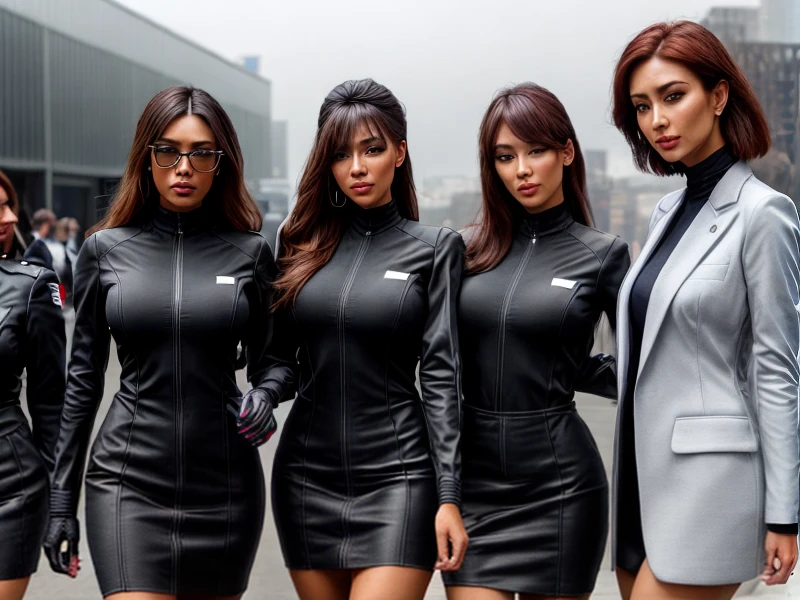Fashion, at its core, is a dynamic reflection of cultural evolution. It acts as both a mirror and a catalyst, reflecting and influencing societal trends and norms. By exploring the profound impact of culture on modern fashion, we can see how tradition and contemporary design intertwine to create the diverse and dynamic landscape of today's fashion. This exploration seeks to uncover how different cultures around the world influence not only fashion trends, but also our understanding of beauty and self-expression in the contemporary era.
Cultural Expression Through Fashion: Bridging History and Modernity
Fashion is a powerful medium for storytelling, reflecting the values, history, and identity of different cultures. Traditional clothing from around the world is more than just clothing; it is a symbol of cultural heritage with a unique story to tell. For instance, the Indian sari and the Japanese kimono are not merely items of clothing but are deeply ingrained symbols of cultural identity and continuity. These garments carry with them centuries of cultural significance and craftsmanship, representing the aesthetic and historical richness of their respective cultures.
Designers today draw immense inspiration from traditional pieces, incorporating elements of their designs, fabrics, and patterns into their contemporary collections. This practice not only honors these cultural legacies but also ensures their continued relevance in the ever-changing world of fashion. By creating a dialogue between old and new, designers allow traditional designs to thrive in modern contexts. This fusion of styles enriches the global fashion landscape, making it more diverse and inclusive.
Globalization and Cross-Cultural Exchange: The Melting Pot of Modern Fashion
The advent of globalization has greatly increased the exchange of fashion ideas and aesthetic concepts across cultures. Today's designers have unprecedented access to a vast array of cultural influences in the form of a global fashion archive, allowing them to blend various styles and traditions in their creative work. This broad perspective not only enhances their collections but also expands the fashion vocabulary for the audience, providing new perspectives and experiences.
African textiles, such as Ankara prints, have made a notable impact on the international fashion stage. Designers like Stella McCartney and brands like Louis Vuitton have embraced these vibrant patterns, incorporating them into their collections and runway shows. The integration of Ankara prints into high fashion exemplifies how traditional elements can find a new life and appreciation on a global scale. This trend towards multicultural inspiration not only pushes the boundaries of fashion design but also promotes a deeper appreciation and understanding of different cultures through the universal language of style.
The influence of globalization in fashion is a testament to the industry’s capacity for creativity and adaptation. As designers weave international influences into their collections, they contribute to a richer, more varied global fashion palette. This not only challenges the norms of traditional fashion but also encourages innovation and diversity in design.
The Role of Social Media in Fashion’s Cultural Exchange
Social media has revolutionized how fashion is shared, consumed, and influenced on a global scale. Platforms like Instagram, Pinterest, and TikTok have given rise to a new generation of fashion influencers and enthusiasts who share their personal styles, drawing from their diverse cultural backgrounds. This digital runway offers unprecedented visibility to various fashion aesthetics from around the world, allowing users to discover and adopt new trends that transcend geographical boundaries.
Influencers from different parts of the world showcase unique styles that might blend traditional cultural elements with modern trends, creating hybrid looks that resonate with a global audience. This exposure not only encourages individual expression but also fosters a more inclusive fashion environment where diversity is celebrated. As a result, styles that may have once been local or niche can gain international appeal and influence, contributing to the global fashion dialogue.
Cultural Appropriation vs. Appreciation: Navigating the Fine Line
While the blending of cultural elements in fashion can lead to vibrant and innovative designs, it also raises important questions about cultural appropriation versus appreciation. The line between the two is often nuanced and requires a deep understanding and respect for the cultural significance behind fashion elements.
Cultural appropriation in fashion occurs when elements of a culture are taken out of context and used in a way that can be disrespectful or reduce cultural expressions to mere fashion statements without acknowledging their true significance. For instance, the use of Native American headdresses in fashion has been criticized for trivializing sacred cultural symbols.
Conversely, cultural appreciation is about engaging with and respecting other cultures, often involving collaboration with cultural representatives and thorough research to ensure that the representations are respectful and informed. Fashion brands and designers can navigate this complex terrain by engaging directly with cultural ambassadors or sourcing materials and designs in a way that benefits the originating communities, both economically and socially.
Sustainability and Ethical Fashion: Embracing Traditional and Eco-Friendly Practices
The intersection of cultural influence and modern fashion also extends to sustainability and ethical practices within the industry. Many contemporary designers are turning to traditional techniques and materials that are inherently sustainable, derived from practices that have been refined over generations.
For example, the use of organic fabrics, natural dyes, and handcrafted textiles are practices rooted in many traditional cultures. These methods not only support sustainable fashion but also help preserve the artisanal skills and cultural heritage of communities around the world. Brands like Patagonia and Eileen Fisher have been pioneers in integrating these ethical practices into their business models, promoting both environmental sustainability and cultural respect.
Furthermore, the fashion industry’s shift towards greater sustainability is often inspired by traditional values of resourcefulness and respect for nature, which are prevalent in many cultures. By adopting these values, the fashion industry not only becomes more environmentally responsible but also pays homage to the cultural wisdom that has long championed such practices.
Integrating Cultural Influences: Strategies for a More Inclusive and Creative Fashion Industry
As the global fashion landscape continues to evolve, it becomes increasingly important for brands and designers to thoughtfully integrate cultural influences into their practices. This integration not only fuels creativity and innovation but also fosters inclusivity and respect within the industry. Here are key strategies to effectively embrace cultural influences while promoting a more ethical and diverse fashion environment.
Collaborative Design Processes
One effective approach to integrating cultural influences is through collaborative design processes that involve creators from the cultures being represented. This not only ensures authenticity but also provides a platform for genuine cultural exchange. By partnering with local artisans, designers can create collections that are not only culturally respectful but also imbued with the rich narratives and craftsmanship of the community. This collaboration can extend beyond design to include all stages of production, providing economic benefits to local communities and promoting sustainable practices.
Educational Initiatives and Cultural Literacy
For the fashion industry to navigate the complexities of cultural appropriation versus appreciation effectively, there is a critical need for education. Brands and designers can benefit from cultural literacy training that encompasses understanding the historical, social, and spiritual significance of cultural elements. Educational initiatives can also be extended to consumers, helping them make more informed choices about the cultural narratives they choose to support through their fashion purchases.
Transparent and Ethical Sourcing
Ethical sourcing is crucial when it involves cultural elements, particularly when these elements are native to indigenous communities or those with less economic power. Transparency in where and how materials are sourced not only ensures respect for the origins but also prevents exploitation. Brands can demonstrate their commitment to ethical practices by providing clear information about the sourcing of materials and the conditions under which garments are produced.
Promoting Cultural Diversity in Fashion Spaces
To truly honor the diversity of cultural influences, the fashion industry must reflect this diversity not just in its designs but also in its leadership, modeling, and promotional campaigns. Encouraging diversity in fashion shows, advertising, and media representation can help normalize inclusivity and ensure that diverse cultural perspectives are valued and visible. This approach not only enriches the industry's creative output but also resonates more deeply with a global audience.
Leveraging Technology for Global Storytelling
In an age where digital platforms have the power to reach millions instantly, fashion brands can leverage these tools to tell compelling stories about the cultures influencing their collections. Through virtual reality experiences, behind-the-scenes documentaries, and interactive online content, brands can educate consumers about the cultural significance behind their collections, enhancing appreciation and respect for the cultural elements used.
Conclusion: The Future of Fashion is Culturally Informed
The impact of cultural influences on modern fashion is undeniable and profound. As the industry looks forward, it is imperative that these influences are handled with care, respect, and a genuine desire to celebrate and preserve cultural heritage. By adopting strategies that promote collaboration, education, ethical sourcing, diversity, and technology-driven storytelling, the fashion industry can achieve a more inclusive, innovative, and respectful approach to integrating cultural influences.
The richness of global cultures offers an endless wellspring of inspiration and opportunity for the fashion industry. By embracing this diversity thoughtfully and ethically, fashion can continue to be a powerful medium for cultural expression and connection, reflecting a world where every thread and pattern tells a story of unity and respect.



